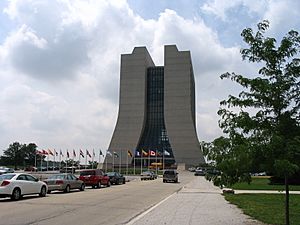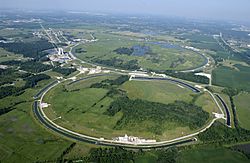Fermilab facts for kids
 |
|
| Established | November 21, 1967 (as National Accelerator Laboratory) |
|---|---|
| Research type | Nuclear |
|
Field of research
|
Particle physics |
| Director | Piermaria J. Oddone |
| Address | P.O. Box 500 |
| Location | Winfield Township, DuPage County / Batavia Township, Kane County, near Batavia, Illinois, USA |
| Affiliations | US Department of Energy University of Chicago Universities Research Association |
| Leon Lederman | |
| Website | fnal.gov |

Fermi National Accelerator Laboratory (often called Fermilab) is a major science lab in Illinois, near Chicago. It's a special national laboratory run by the United States Department of Energy. Scientists at Fermilab study tiny particles that make up everything in the universe. They use powerful machines called particle accelerators to do this.
Fermilab's Tevatron was once the second largest particle accelerator in the world. It was a huge ring, about 3.9 miles (6.3 km) around. In 1995, scientists at Fermilab made a big discovery: they found the top quark, one of the basic building blocks of matter. The Tevatron was turned off in 2011, but Fermilab still does many other important experiments.
Besides studying high-energy collisions, Fermilab also works on neutrino experiments. Neutrinos are tiny particles that can travel through almost anything. Experiments like MiniBooNE and MINOS use special detectors to study them. For example, the MINOS experiment sends a beam of neutrinos 455 miles (732 km) through the Earth to a mine in Minnesota!
Fermilab is built on a large piece of land. Scientists decided to use some of this land to bring back Illinois' original prairie (a type of grassland). They also started a farm to raise a herd of American bison. There's even an asteroid named after the laboratory: 11998 Fermilab.
History of Fermilab
After World War II, the US government funded different universities to build particle accelerators. These machines helped scientists study the smallest parts of atoms. But by the 1960s, these "atom smashers" were getting too big and expensive for just one university campus. The government decided to create a new, large lab that physicists from many universities could use. They chose a site in Illinois.
A small community called Weston, Illinois, was located where the lab needed to be built. The town voted to sell all its land and houses to Fermilab. The town then officially closed down.
The laboratory started in 1967 as the National Accelerator Laboratory. It was renamed Fermilab in 1974, honoring the famous scientist Enrico Fermi. The lab's first director was Robert Rathbun Wilson. He was known for getting the lab built ahead of schedule and under budget. He also created many sculptures that are still on the campus today. The main laboratory building, called Wilson Hall, is named after him. It's a very unique building and a symbol of Fermilab.
Before the new buildings were ready, scientists lived and worked in the houses from the old town of Weston. This area is now called "Fermilab Village" and still provides housing for visiting scientists.
After Robert Wilson, Leon Lederman became the director in 1978. Under his leadership, the original accelerator was replaced with the Tevatron. This new machine could smash protons and antiprotons together at very high energies. Lederman stepped down in 1988. There is now a science education center at Fermilab named in his honor.
Fermilab continues to be a leader in particle physics. It works with other big labs around the world, like CERN in Europe, which has the Large Hadron Collider.
How Accelerators Work
Particle accelerators at Fermilab speed up tiny particles to nearly the speed of light. This allows scientists to study what happens when these particles crash into each other. Here's how it works:
- First Step: Making Ions
The process starts with hydrogen gas. Scientists turn this gas into negatively charged hydrogen ions (H−). These ions are then given a first push by a machine called a Cockcroft–Walton generator. This machine uses an electric field to speed them up.
- Linear Accelerator (Linac)
Next, the ions enter the linear accelerator, or "linac." This is a straight tube that makes the particles go even faster, reaching about 70% of the speed of light. Before entering the next part, the H− ions pass through a thin carbon foil. This removes electrons, turning them into positively charged protons (H+).
- Booster Ring
The protons then go into the booster ring. This is a circular accelerator about 468 meters (1,535 feet) around. Magnets bend the protons in a circle. As they go around, electric fields give them more energy. The protons circle the booster about 20,000 times in just 33 milliseconds!
- Main Injector
The Main Injector is the next big step. It was finished in 1999 and acts like a "particle switchyard." It speeds up protons even more. It also helps create antiprotons and then speeds them up too.
- Tevatron (Now a Museum)
The Tevatron was the final and most powerful accelerator at Fermilab. Protons and antiprotons would travel in opposite directions around its 3.9-mile (6.3 km) ring. Scientists would make them collide inside huge detectors like DØ and CDF. These collisions helped them learn about the early universe and the smallest parts of matter. The Tevatron is now being turned into a museum.
Fermilab's accelerators also have a medical use. Doctors can use protons or neutrons from the accelerator to treat people with cancer. They shoot these particles into tumors to destroy them.
Experiments at Fermilab
Fermilab is home to many important experiments that help us understand the universe. Some of these include:
- Holometer interferometer
- Tevatron proton-antiproton collider: DØ and Collider Detector at Fermilab
- MiniBooNE: Mini Booster Neutrino Experiment
- Sciboone: SciBar Booster Neutrino Experiment
- MINOS: Main Injector Neutrino Oscillation Search
- MINERνA: Main INjector ExpeRiment with νs on As
- NOνA: NuMI Off-axis νe Appearance
- MIPP: Main Injector Particle Production
Images for kids
See also
 In Spanish: Fermilab para niños
In Spanish: Fermilab para niños








